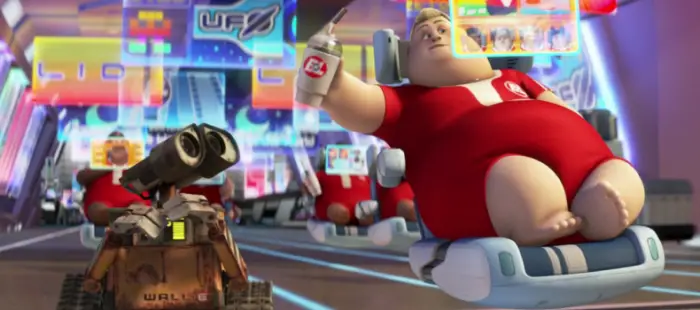Humans have always had a knack for innovation. Whether it’s tinkering with the advancement of our weapons in the Stone Age or creating cars that drive themselves; if we can improve upon it, humans have probably already done so. (Or we’re attempting to find a way to get it done; we’re tenacious like that.)
This is why I find Pixar’s WALL-E so interesting when we focus on this month’s Sci-Fi topic of Artificial Intelligence. Pixar—like Studio Ghibli, who I love—has an irrefutable talent at not only making movies for all ages to enjoy, but slipping insightful social commentary into their narratives. Although the robots in WALL-E only borderline hint at AI (their developing personal motivations a major insight to that), the movie does a wonderful job at giving them larger than life personalities and roles. WALL-E creates a beautiful dichotomy of innovation and the importance attached to it. The film puts forth that big, overarching question of “yes, we can, but should we?”
Pixar does a fantastic job at showing and not telling when it comes to the initial setting of the movie. WALL-E begins with a devastated planet Earth, one absolutely adorable robot, and his equally adorable cockroach sidekick. We realize that our attempts at clean energy and overall environmentalism (when it comes to turning to minimalism) has failed, miserably. And in lieu of all that, humans have evacuated Earth and left behind robots. The purpose of the WALL-E series robot is to rehabilitate the planet and clean up the mess we’ve made. One that was created based on our wants, rather than our needs.
It’s a grim message and it is only offset by WALL-E’s charm and humour. His humming is infectious and I dare you not to smile at his fascination with humans and all the things left behind. His tiny home is a treasure trove of knick-knacks. It holds anything from charming musical films, to bowling pins, and of course paddle balls—that, of course, does end up in the ‘do not keep’ pile (much to my amusement).
The beginning of WALL-E does a great job at establishing two major truths to help advance the film. First, we’re now—or you should be—officially in love with a small robot with a big personality (who seems to hate mornings as much as I do). This ensures that we’re heavily invested in WALL-E and his adventures, and oh boy, are we ever. And secondly, we realize, that as humans, we have passed the buck on our accountability and overall stewardship of Earth to robots. We’re very literally letting someone else clean up the mess that we made.
This might seem like a silly connection to make but considering this is geared towards children, I feel like it’s fair game to point this out. I’m positive most of us have heard some variation of the “clean up” song in pre-school. The purpose behind it is to demonstrate to children the importance of responsibility towards our actions and their consequences. Yes, in pre-school it’s all about cleaning up your blocks, cars, or whatever it may be, but it helps children understand ownership.
In WALL-E, we are shown a future where we don’t learn or acknowledge our mistakes, as we don’t associate with them. Instead, we’ve placed a quick fix—the creation of cleaning robots like WALL-E—and have moved our focus to the next big idea. We don’t learn or try to innovate ourselves anymore. Humanity’s main focus is on creating bigger and better products, as seen by the introduction of newer robots like EVE.
Unfortunately for the humans in WALL-E, the machines do understand the importance of upgrading and responsibility. EVE’s purpose was to find signs of life on Earth and bring it back to the Axiom, the ship where humans have been living for the last 700 years, give or take a decade. The ship itself highlights the values of humankind as it was created and sponsored by Buy N Large corporation (BNL)—the same company who’s billboards were plastered over the ruins of Earth at the beginning of the movie.

If there was an ounce of argument before that humans weren’t completely indoctrinated by material goods, that’s utterly gone now. They’re far more focused on whether they should wear the red jumpsuit or the blue (a lovely allusion to The Matrix might I add) and have entered a society where they ignore other humans. Once again, WALL-E could get quickly dark here as arguably one of the biggest things that set humans aside from any other species is our need for communication, companionship, and that desire to create. Aboard the Axiom, all of that’s gone and almost forgotten, if not for the files that Captain B. McCrea begins to tap into.
AUTO is an easy antagonist for children and audiences alike. The robots in WALL-E are simply following their directives given to them by humans. Whether that’s cleaning the ship, finding signs of life on Earth, or ensuring that humans are taken care of, each robot has a roll and does it flawlessly (too much so). The main issue in the film is the idea of giving up too much of our own liability towards ourselves and our lives and having something that we’ve created begin to make decisions for us.
WALL-E‘s AUTO isn’t as sinister as HAL 9000 from 2001: A Space Odyssey but the robot AI certainly shows the aforementioned issue of decision making concerning our lives in a lighter manner. It all goes back to the original question of when do we stop trying to create something that fixes our mistakes for us, and instead simply begin to actually just fix the mistake at hand? WALL-E shows us a future where we take control back. One where we begin to acknowledge the issue with our complicity towards our future and shoving the problems onto the next generation. Or in the case of WALL-E, the next intelligent being. The humans in WALL-E had to wait almost a millennium until Earth was viable again.
It’s a very scary potential future and though the AI wasn’t as vicious as it could be, Pixar alludes to that future where we do let things, or AI, get out of control—or perhaps too in control. Ultimately, only humans are the ones who should be able to make decisions about the future concerning ourselves. Especially, considering we are as dynamic as Earth. Humans are constantly evolving, innovating, and hopefully changing ourselves for the better. Therefore shouldn’t we be the ones to make change because we ourselves are change? Pixar gently pushes the narrative of the repercussions of when we allow someone, or something else, to fix our problems for us. We just might not like their answer.



